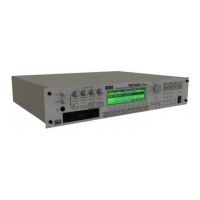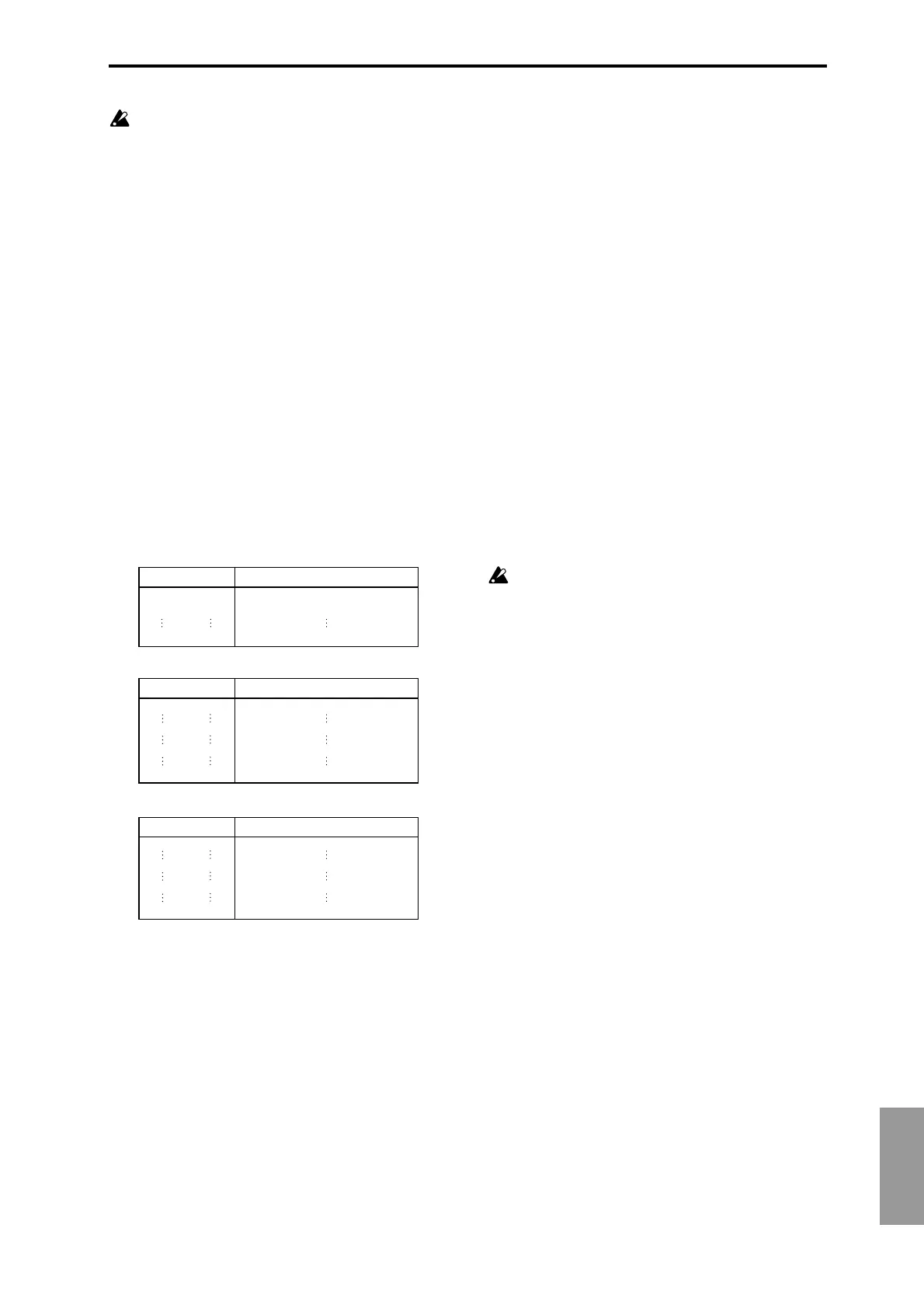Appendices
219
Any control change number (CC#00–95) can be
assigned as the B-mode function of a REALTIME CON-
TROLS knob. In this case, the transmitted values will all
be 0–127.
*1 For pattern data in Multi mode, bank select is normally
specified using program change events (“Event Edit
MULTI 5.1–1e). However, this may not be sufficient
when you need to change banks on an external device.
In such cases, use CC#00 and CC#32.
For information on the relation between bank select
numbers and the banks of your external device, refer to
the owner’s manual for your external device.
*2 Unlike conventional control changes, pitch bend range,
fine tune, and coarse tune settings are made using RPC
(Registered Parameter Control) messages. In Program,
Combination, and Multi modes, you can use RPC mes-
sages to control the bend range and tuning for each pro-
gram, combination (Combination), or track (Multi). The
procedure is to use an RPN (Registered Parameter Num-
ber) message to select the parameter that you wish to
edit, and then use Data Entry to input a value for that
parameter. To select the parameter, use CC#100 (with a
value of 00–02) and CC#101 (with a value of 00). use
CC#06 and CC#38 to enter the data.
The data entry values for each parameter and the corre-
sponding settings are as follows.
For example, if in Multi mode you wish to set a track
that is receiving channel 1 to a transpose (coarse tuning)
value of -12, you would first transmit [B0, 64, 02]
(64H=CC#100) and [B0, 65, 00] (65H=CC#101) to the
TRITON-Rack to select the RPN coarse tune. Then you
would set this to -12 by transmitting [B0, 06, 34]
(06H=CC#6), 34H=52 (corresponds to –12), and [B0, 26,
00] (26H=CC#38, 00H=0).
*3 The volume of the TRITON-Rack is determined by multi-
plying the Volume (CC#07) with the Expression (CC#11).
When you select a multi in Multi mode, the volume will
be set to the values specified for each track, and the
expression will be set to the maximum value (127).
*4 A value of 64 will correspond to the value specified by the
program parameter. 0 will be the minimum, and 127 will
be the maximum. Changing from 63–1 or from 65–126
will adjust the effect from the program parameter setting
toward the minimum value or maximum value. The
internal program parameters listed in (*4, *5) will be con-
trolled.
*5 If the filter type of the corresponding program is Low
Pass Resonance, the filter resonance level will be con-
trolled. If the filter type is Low Pass & High Pass, the
cutoff frequency of the high pass filter will be controlled.
*4, *5
CC#70–79 correspond to the following program param-
eters of the TRITON-Rack.
In Program mode, when CC#70–79 is received on the
global MIDI channel (“MIDI Channel” GLOBAL 2.1–1a),
or when a REALTIME CONTROLS [1]–[4] knob is oper-
ated in A-mode or in B-mode when the function is
assigned to CC#70–79, the corresponding program
parameter will be edited temporarily. You can execute
“Write Program” (PROG 1.1–1d)) to save that state
(except for some parameters). When you execute “Write
Program,” the values of the corresponding program
parameters will be rewritten.
In Sampling mode when playing the currently selected
multisample on the keyboard, the same control changes
or knob operations as in Program mode will temporarily
edit the corresponding program parameters. You can use
“Conv. To Program (Convert Multisample To Program)”
(Sampling 1.1–3g) to save that state as a program (except
for some parameters).
In Combination, and Multi modes, the program param-
eters of the program for the timbre/track of the corre-
sponding MIDI channel will change, but this state can
not be saved directly in the program.
CC#70: Sustain level
Corresponds to “Filter/Amp EG Sustain Level” (PROG 4.1/
2: Ed–Filter1/2, EG page, 5.1/2: Ed–Amp1/2, EG page).
CC#71: Filter resonance level/High pass filter cutoff frequency
Corresponds to “Filter A Resonance” (PROG 4.1/2: Ed–
Filter1/2, Basic page).
Corresponds to “Filter B Frequency” (PROG 4.1/2: Ed–
Filter1/2, Basic page).
CC#72: Release time
Corresponds to “Filter/Amp EG Release Time” (PROG 4.1/
2: Ed–Filter1/2, EG page, 5.1/2: Ed–Amp1/2, EG page).
CC#73: Attack time
Corresponds to Filter/Amp EG Attack Time” ((PROG 4.1/2:
Ed–Filter1/2, EG page, 5.1/2: Ed–Amp1/2, EG page)
Corresponds to “Amp EG Start Level” (PROG 5.1/2: Ed–
Amp1/2, EG page).
Corresponds to “Amp EG Attack Level” (PROG 5.1/2: Ed–
Amp1/2, EG page).
Corresponds to “Amp EG Level Modulation Start” (PROG
5.1/2: Ed–Amp1/2, EG page).
Corresponds to “Amp EG Time Modulation Attack” (PROG
5.1/2: Ed–Amp1/2, EG page).
CC#74: Low pass filter cutoff frequency
Corresponds to “Filter A Frequency” (PROG 4.1/2: Ed–
Filter1/2, EG page).
Corresponds to “Filter B Frequency” (PROG 4.1/2: Ed–
Filter1/2, EG page).
CC#75: Decay time
Corresponds to “Filter/Amp EG Decay Time” (PROG 4.1/2:
Ed–Filter1/2, EG page, 5.1/2: Ed–Amp1/2, EG page)
Corresponds to “Filter/Amp EG Slope Time” (PROG 4.1/2:
Ed–Filter1/2, EG page, 5.1/2: Ed–Amp1/2, EG page)
CC#06 CC#38
00
01
12
00
00
0
0
+ 1
+12
CC#06 CC#38
40
52
64
88
00
00
00
00
–24
–12
0
+24
CC#06 CC#38
32
48
64
96
00
00
00
00
–50
–25
0
+50
RPN=0 (Pitch bend range)
RPN=1 (Fine tune)
RPN=2 (Coarse tune)
Parameter value (Semitone steps)
Parameter value (Semitone steps)
Parameter value (1 cent steps)

